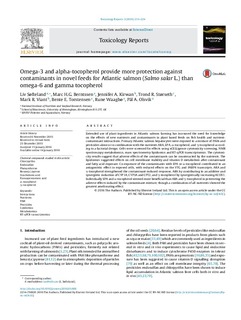| dc.contributor.author | Søfteland, Liv Ingeborg Rosvoll | |
| dc.contributor.author | Berntssen, Marc | |
| dc.contributor.author | Kirwan, Jennifer A. | |
| dc.contributor.author | Størseth, Trond Røvik | |
| dc.contributor.author | Viant, Mark.R. | |
| dc.contributor.author | Torstensen, Bente Elisabeth | |
| dc.contributor.author | Waagbø, Rune | |
| dc.contributor.author | Olsvik, Pål Asgeir | |
| dc.date.accessioned | 2019-02-15T20:52:44Z | |
| dc.date.available | 2019-02-15T20:52:44Z | |
| dc.date.created | 2016-01-27T07:51:09Z | |
| dc.date.issued | 2016 | |
| dc.identifier.citation | Toxicology reports. 2016, 3 211-224. | nb_NO |
| dc.identifier.issn | 2214-7500 | |
| dc.identifier.uri | http://hdl.handle.net/11250/2585784 | |
| dc.description.abstract | Extended use of plant ingredients in Atlantic salmon farming has increased the need for knowledge on the effects of new nutrients and contaminants in plant based feeds on fish health and nutrient-contaminant interactions. Primary Atlantic salmon hepatocytes were exposed to a mixture of PAHs and pesticides alone or in combination with the nutrients ARA, EPA, α-tocopherol, and γ-tocopherol according to a factorial design. Cells were screened for effects using xCELLigence cytotoxicity screening, NMR spectroscopy metabolomics, mass spectrometry lipidomics and RT-qPCR transcriptomics. The cytotoxicity results suggest that adverse effects of the contaminants can be counteracted by the nutrients. The lipidomics suggested effects on cell membrane stability and vitamin D metabolism after contaminant and fatty acid exposure. Co-exposure of the contaminants with EPA or α-tocopherol contributed to an antagonistic effect in exposed cells, with reduced effects on the VTG and FABP4 transcripts. ARA and γ-tocopherol strengthened the contaminant-induced response, ARA by contributing to an additive and synergistic induction of CYP1A, CYP3A and CPT2, and γ-tocopherol by synergistically increasing ACOX1. Individually EPA and α-tocopherol seemed more beneficial than ARA and γ-tocopherol in preventing the adverse effects induced by the contaminant mixture, though a combination of all nutrients showed the greatest ameliorating effect. | nb_NO |
| dc.language.iso | eng | nb_NO |
| dc.publisher | Elsevier | nb_NO |
| dc.rights | Attribution-NonCommercial-NoDerivatives 4.0 Internasjonal | * |
| dc.rights.uri | http://creativecommons.org/licenses/by-nc-nd/4.0/deed.no | * |
| dc.subject | Interactions | nb_NO |
| dc.subject | Nutrients | nb_NO |
| dc.subject | PAH | nb_NO |
| dc.subject | Pesticides | nb_NO |
| dc.subject | Lipidomics | nb_NO |
| dc.subject | Metabolomics | nb_NO |
| dc.subject | RT-qPCR | nb_NO |
| dc.title | Omega-3 and alpha-tocopherol provide more protection against contaminants in novel feeds for Atlantic salmon (Salmo salar L.) than omega-6 and gamma tocopherol | nb_NO |
| dc.type | Journal article | nb_NO |
| dc.type | Peer reviewed | nb_NO |
| dc.description.version | publishedVersion | nb_NO |
| dc.rights.holder | © 2016 The Authors. Published by Elsevier Ireland Ltd. This is an open access article under the CC-BY-NC-ND license (http://creativecommons.org/licenses/by-nc-nd/4.0/). | nb_NO |
| dc.source.pagenumber | 211-224 | nb_NO |
| dc.source.volume | 3 | nb_NO |
| dc.source.journal | Toxicology reports | nb_NO |
| dc.identifier.doi | 10.1016/j.toxrep.2016.01.008 | |
| dc.identifier.cristin | 1323293 | |
| cristin.unitcode | 7566,6,0,0 | |
| cristin.unitname | Miljø og nye ressurser | |
| cristin.ispublished | true | |
| cristin.fulltext | original | |
| cristin.qualitycode | 1 | |

